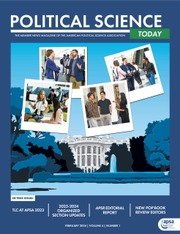Americans watch a lot of television, averaging over four hours per day. It’s no wonder, then, that political scientists have long studied the impact of media on politics—from the effects of campaign advertisements on voter turnout to the role of partisan media in polarization. However, the media that has dominated research attention is typically explicitly political. The idea that entertainment media can influence politics has often been met with skepticism. When studied, it was usually within the context of its substitution effect. However, Kim and Patterson challenge this view in their newly published article, “The American Viewer” (a title that pays tribute to the classic, The American Voter). They argue that entertainment media creates unique opportunities for celebrities to build personal bonds with voters. When these non-political actors run for office, they can leverage these parasocial ties to appeal to voters.

The authors focus on perhaps the most illustrative example of entertainment media’s influence on American politics—the rise of Donald Trump. Before running for office, Trump hosted the reality TV show The Apprentice for eleven years. The show, where contestants competed for a prestigious opportunity to work for Trump, aired between 2003 and 2015 and attracted over 28 million viewers at its peak. It has long been a popular hypothesis among political pundits and journalists that Trump benefited from his reality TV brand. Indeed, the authors demonstrate how frequently mainstream news media referenced The Apprentice during the 2016 election cycle.

To systematically study whether and to what extent The Apprentice helped Donald Trump’s electoral chances, Kim and Patterson turned to two different data sources. First, using Twitter data, they found that about 69% of the followers of the NBC Apprentice account also followed Donald Trump, while only 12% followed Marco Rubio and 8% followed Ted Cruz. Second, they analyzed a survey of white voters conducted before the 2016 presidential election. The survey revealed that frequent viewers of The Apprentice exhibited higher levels of support for Trump than non-viewers. In contrast, non-viewers who supported Trump were more likely to evaluate his campaign along more typical partisan lines. Moreover, in open-ended responses, these voters frequently mentioned Trump’s personality traits (“a lot tougher,” “speaks his mind”) more often than those who had never seen The Apprentice.
The authors go beyond merely showing correlations. For causal inference, they leverage the fact that in the early 2000s, before the rise of streaming services like Netflix, many Americans tended to stay on the same channel for the entire evening. In the 2004 TV season, on Thursdays, The Apprentice (9 pm) aired right after the popular 8 pm sitcoms Will & Grace and Joey. In other words, some people ended up watching The Apprentice not because they had a strong affinity for the show or Trump, but simply because they were watching a popular sitcom on NBC at 8 pm and didn’t bother switching the channel. Using this “channel inertia” as an instrument, Kim and Patterson demonstrate that entertainment media causally affected the county-level vote share for Trump during the Republican primary. However, they found no evidence of similar effects for the general election, where the power of partisan identity plays a much more significant role than in a primary setting, where such heuristics are absent, leading voters to rely more on other considerations like name recognition.
At a time when news consumption is declining globally, this study helps us better understand how ostensibly non-political media can powerfully influence our politics. After all, “[I]t is difficult to distinguish politics from entertainment, and dangerous to try.” ■
KIM, EUNJI, and SHAWN PATTERSON. 2024. “The American Viewer: Political Consequences of Entertainment Media.” American Political Science Review: 1–15. https://doi.org/10.1017/S0003055424000728


